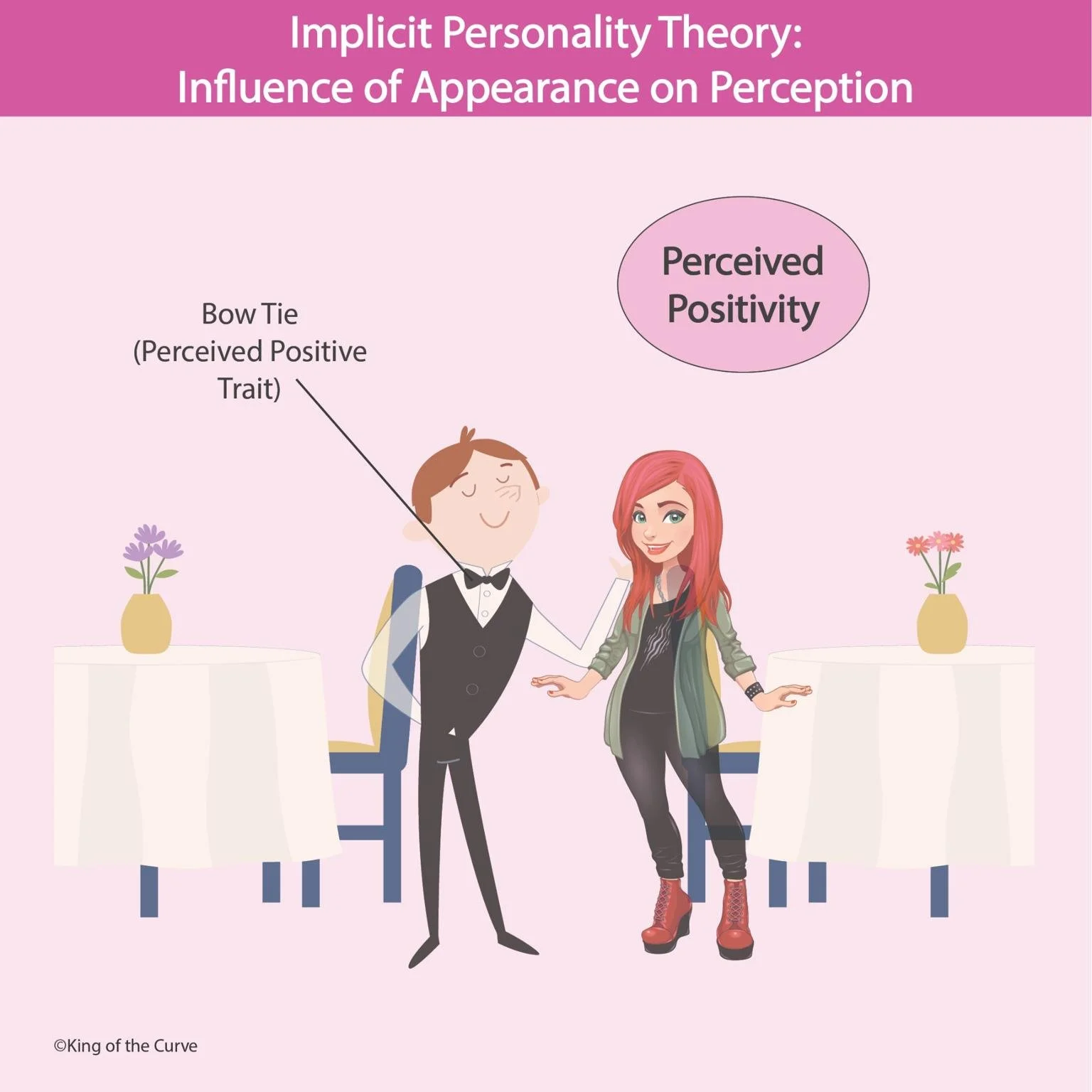🧠 Implicit Personality Theory: Influence of Appearance on Perception
Implicit Personality Theory refers to the subconscious process through which we form opinions about others based on limited information—often their appearance or behavior. We tend to assume that certain traits or characteristics naturally go together.
👕 The Role of Appearance in Social Perception
As shown in the image, physical appearance and attire play a significant role in shaping how others perceive us.
In this case:
The bow tie is interpreted as a perceived positive trait, symbolizing sophistication or politeness.
This single visual cue contributes to perceived positivity, meaning observers may view the individual more favorably overall.
This demonstrates a key principle of the Implicit Personality Theory—halo effect—where one positive characteristic influences how we view a person’s entire personality.
⚙️ Cognitive Mechanism
Here’s how it works step-by-step:
Observation: We notice a distinct feature (like clothing, tone, or body language).
Association: The brain links that feature to familiar stereotypes or experiences.
Generalization: We form assumptions about the person’s overall character.
For instance, seeing someone in professional attire might trigger associations with competence or success.
⚖️ Implications in Real Life
This subconscious pattern influences many areas of daily life, including:
Hiring decisions — recruiters may prefer candidates who “look professional.”
Social interactions — people often gravitate toward those who appear friendly or confident.
Education — teachers may unconsciously rate neatly dressed students as more capable.
Understanding this theory helps reduce bias and encourages objective evaluation of others beyond surface-level traits.
🧩 Psychological Insight
The Implicit Personality Theory not only affects how we perceive others but also how we present ourselves. People often engage in impression management, consciously curating their appearance or behavior to influence others’ perceptions.
Recognizing these subconscious associations allows us to strike a balance between authenticity and self-awareness—being mindful of how first impressions form while staying true to who we are.
❤️ Key Takeaways Table
| Concept | Description |
|---|---|
| Definition | Forming personality assumptions based on limited observable traits. |
| Example | Assuming a person wearing a bow tie is intelligent and polite. |
| Cognitive Bias | Halo Effect — one positive trait leads to generalized positivity. |
| Common Contexts | Job interviews, first impressions, social and academic settings. |
| Practical Tip | Be mindful of snap judgments; focus on behavior and evidence instead of looks. |
🚀 Call to Action
Be aware of your automatic judgments the next time you meet someone new. Ask yourself: “Am I forming this opinion based on their appearance or their actions?”
Challenge your assumptions, expand your understanding, and foster meaningful connections that go beyond surface-level perceptions.
If you’re passionate about psychology and want to explore more fascinating insights like this, follow King of the Curve for evidence-based educational visuals and blogs that make complex topics easy to understand.
✨ Summary
The Implicit Personality Theory highlights how deeply our perceptions are shaped by automatic associations. While these shortcuts help us navigate social life, being aware of them can lead to fairer and more accurate judgments about others.
Ultimately, understanding these psychological patterns empowers us to see people as they truly are—not just how they appear.
Frequently Asked Questions (FAQs)
-
Aim for 4-6 focused hours, ensuring you incorporate breaks to avoid burnout.
-
Practice mindfulness techniques, take practice exams under realistic conditions, and maintain a balanced lifestyle.
-
Set short-term goals, seek support from mentors, and reward yourself for small achievements.
-
Regular exercise improves focus, reduces stress, and enhances overall mental clarity.
-
KOTC offers personalized learning tools, gamification features, and adaptive question banks to help students stay on track without burnout.


